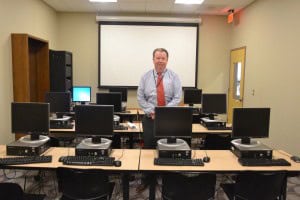
Over the past few years, technology has advanced at a rapid pace. When Director Joseph E. Galbraith first joined the Moorestown Library staff in 1996, he said the library had one public Internet computer and one staff Internet computer, both on dial-up, moving at glacial speeds. Now the library has high speed Internet available free and wirelessly to any Moorestown Library cardholder for their smartphone, tablet and laptop.
The Moorestown Library makes it a part of its mission to keep up with technology, and over the years, it has done exactly that. It has learned to evolve to the trends in technology so it can remain relevant and useful to the residents who use its services.
“The changes in technology have been just phenomenal, and it is very important we keep up with it because a lot of people depend on the library for their technology,” Galbraith said.
According to Galbraith, library technology in particular has seen some big changes. The periodicals have now gone onto CDs, books on tape have been put on CDs, books are now downloadable to digital devices, and libraries are now accessible online 24/7. The Moorestown Library has all of these advancements under its belt, plus a social media presence and a mobile app.
In addition to free high-speed wireless internet, the library has 16 high-speed, public access computers with Microsoft Office; a self check-out system; two meeting rooms with integrated AV systems and wireless internet; a learning lab with 20 desktop PCs; a public fax machine; a secure shredding machine; color copiers and printers with free scanning to USBs; downloadable eBooks and audio books; digital access to the library’s most popular magazine titles on phone, tablet or PC; more than 5,000 DVDs; thousands of music CDs and books on CD; and the free library mobile app.
“And that is just today. As time goes on, we will be adding more and more,” Galbraith said.
With the current technology and a lot of information now available through the Internet, many believe libraries are on their way out. However, Galbraith said people felt that way about libraries when bookstores such as Borders and Barnes & Noble entered the scene. It’s all about adapting.
Bookstores used to offer comfortable seating and cafes for people to sit and spend time there, but they didn’t end up buying anything. Many stores closed or had to get rid of these additions, but libraries used those ideas to their advantage. They added comfortable seating, cafes and the like so people would spend time at the library and use their services. And they are still lasting.
“We are still relevant and we’ll probably still be relevant 30 years from now,” Galbraith said.
Galbraith said libraries are important as the repositories of society’s records, and to stay relevant, they must adapt.
“Our goal is to be relevant, and in order to do that, we have to be ready to change, adapt and evolve to what our communities need from us,” Galbraith said.
Supported by local municipal tax dollars — instead of by the county or state — the Moorestown Library is able to respond directly to what the citizens need. He said it is the library’s job to make sure the tax dollars are well spent and adhere to what the residents and community needs.
To learn more about what else is available at the library, the services it provides and any questions, you can visit the library at 111 W. Second St., online at www.moorestown.lib.nj.us/staff.html, or call (856) 234–0333.
“Come in and see us, see what we have to offer,” Galbraith said.


